Havanese dogs have minimal shedding thanks to their single coat. Shedding levels can be influenced by diet, genetics, health, and the environment. Understanding these factors is crucial for proper grooming. Maintaining a balanced diet and regular veterinary check-ups can help reduce shedding. Essential grooming tools such as brushes and deshedding tools should be used. It is important to recognize allergies and shedding patterns. Consistent grooming and a nutritious diet can help manage shedding. Shedding frequency can also be affected by hormones and seasons. Providing proper care is essential for keeping their coat healthy. Keep in mind that there is always more to learn about managing shedding in Havanese dogs!
Key Takeaways
- Minimal shedding due to single coat structure.
- Shedding influenced by diet, health, genetics, and seasons.
- Regular grooming with appropriate tools reduces loose hair.
- Understanding shedding patterns aids in effective management.
- Genetics play a significant role in shedding tendencies.
Shedding Patterns in Havanese
When observing shedding patterns in Havanese dogs, it becomes evident that their minimal shedding is primarily attributed to their single coat structure. Unlike breeds with double coats, Havanese dogs possess only one layer of fur, which greatly reduces the amount of hair they shed. This single coat structure plays an important role in maintaining their fluffy appearance while keeping shedding to a minimum.
Havanese dogs exhibit shedding variations that are influenced by shedding factors such as diet, health, genetics, and their longer hair growth cycle. While they generally have moderate shedding, there are times when they may experience heavier shedding, especially during seasonal changes or due to factors like temperature, daylight exposure, and hormonal fluctuations. Understanding these shedding patterns can help Havanese owners anticipate and manage their dog's grooming needs effectively.
Factors Influencing Havanese Shedding

Minimizing shedding in Havanese dogs is primarily achieved due to their single coat structure. Several factors influence the shedding patterns in these pets:
- Diet: Providing a balanced diet rich in essential nutrients can promote a healthy coat and minimize shedding.
- Health: Regular vet check-ups and ensuring your Havanese is in good health can help reduce excessive shedding.
- Genetics: The genetic makeup of your pet can play a significant role in their shedding tendencies.
- Environmental Factors: Seasons, temperature variations, exposure to daylight, and hormonal changes can all impact the shedding frequency in Havanese dogs.
Understanding these factors and how they influence shedding can help pet owners better manage their Havanese's coat and overall grooming needs. By paying attention to these aspects, you can help maintain a healthy coat and minimize shedding in your furry companion.
Grooming Practices for Minimizing Shedding
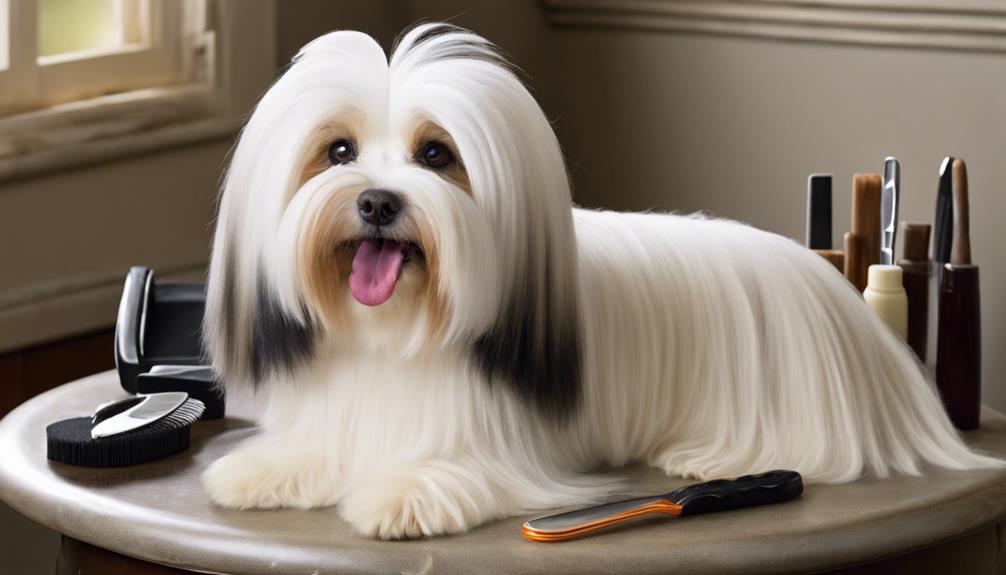
In order to effectively manage shedding in Havanese dogs, regular grooming practices play a critical role in maintaining their single coat structure and preventing excessive hair loss. Havanese dogs have minimal shedding, but to further minimize it, consistent grooming is crucial. Using slicker and pin brushes helps manage loose hair and prevents matting, which can lead to more shedding.
Lifestyle adjustments such as a balanced diet and regular exercise also contribute to reducing shedding. Employing shedding brushes and deshedding tools is vital to effectively control the amount of loose hair. Additionally, natural remedies and dietary supplements can promote skin and coat health, further reducing shedding in Havanese dogs.
Understanding Allergies and Shedding
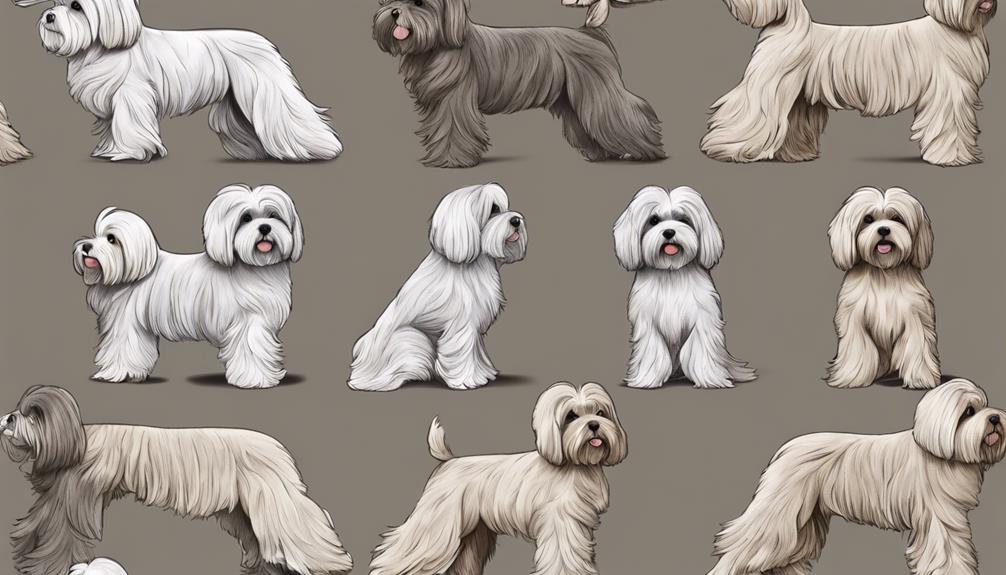
Understanding the correlation between allergies and shedding is essential for maintaining a Havanese dog's well-being and minimizing potential health issues. Here are some key points to contemplate:
- Havanese shedding: While Havanese dogs are known for their hypoallergenic qualities, they can still trigger allergic reactions in sensitive individuals due to shedding.
- Allergic reactions: Allergies can be exacerbated by allergen exposure from a Havanese dog's shedding, leading to discomfort and health issues if not managed properly.
- Grooming practices: Regular grooming practices play a pivotal role in reducing shedding and minimizing allergen exposure, making it easier to manage allergies for both the dog and its owners.
- Professional grooming services: Seeking professional grooming services can aid in shedding management and overall well-being for Havanese dogs, ensuring that their coat is properly cared for to reduce shedding and potential allergic reactions.
Tips for Managing Shedding in Havanese Dogs

When it comes to managing shedding in Havanese dogs, grooming techniques play an essential role in keeping their coat in top condition.
Additionally, the impact of diet on shedding patterns shouldn't be overlooked, as a balanced diet can help minimize excessive hair loss.
Understanding the variations in shedding seasons can also aid in effectively managing your Havanese's shedding tendencies.
Grooming Techniques for Shedding
Regular grooming with slicker and pin brushes is essential for managing shedding in Havanese dogs. Here are some tips to help you keep your Havanese's shedding under control:
- Brush Regularly: Use slicker and pin brushes to remove loose hair and prevent matting.
- Bathe Strategically: Follow a regular bathing schedule to keep your dog's coat clean and healthy, reducing shedding.
- Maintain a Balanced Diet: Providing a nutritious diet can help minimize excessive shedding in your Havanese.
- Stay Active: Regular exercise not only keeps your dog healthy but can also contribute to reducing shedding.
Diet Impact on Shedding
Maintaining a balanced diet plays an important role in managing shedding for Havanese dogs. Including Omega-3 fatty acids, such as those found in fish oil supplements or quality food, can help keep their coat healthy and reduce shedding.
Opt for high-quality protein sources like chicken or lamb to support coat growth and minimize excessive shedding. Be mindful of potential food allergies by sticking to a vet-approved diet, as these can contribute to skin issues that impact shedding.
Shedding Season Variations
To effectively manage shedding in Havanese dogs, understanding the seasonal variations in their coat shedding is vital. Here are some tips for managing shedding in Havanese dogs:
- Regular grooming is essential to remove loose hair and prevent matting in their single coat structure.
- Be aware that shedding in Havanese can vary seasonally, with some dogs shedding more during specific times.
- Factors like diet, health, and genetics can influence the shedding patterns in Havanese dogs.
- By understanding shedding variations in Havanese, you can engage in effective grooming practices to keep their coat healthy and minimize shedding.
Products for Controlling Shedding
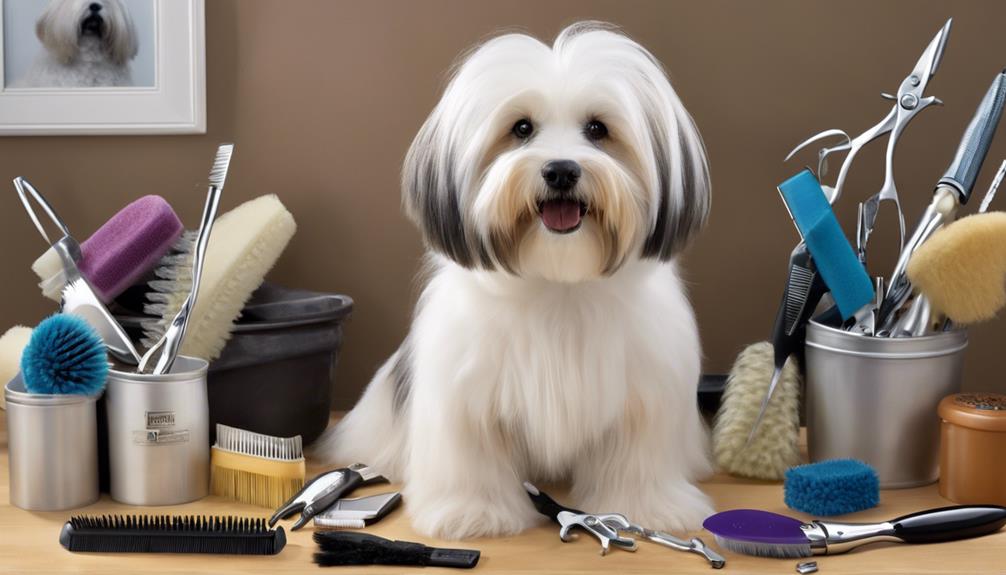
When it comes to controlling shedding in Havanese dogs, there are several products that can help. Deshedding tools like slicker brushes are effective in managing loose hair, while regular use of pin brushes can assist in maintaining coat condition.
Additionally, considering the impact of diet on shedding and exploring natural remedies or supplements can promote skin and coat health to reduce shedding.
Shedding Control Methods
In managing shedding in Havanese dogs, utilizing shedding brushes and deshedding tools proves to be effective for controlling loose hair. Here are some shedding control methods for your Havanese:
- Regular grooming with slicker and pin brushes can help minimize shedding.
- Lifestyle adjustments like providing regular exercise and a balanced diet play a role in shedding control.
- Natural remedies such as dietary supplements and homemade solutions promote skin and coat health, reducing shedding.
- Professional grooming services can aid in shedding management and overall well-being for your Havanese.
Grooming Tools for Shedding
Grooming tools designed for shedding control in Havanese dogs are essential for maintaining a healthy coat and minimizing loose hair. Slicker brushes work well to remove the loose hair from their coat, while pin brushes help prevent matting and detangle fur effectively. Shedding brushes are handy in controlling the amount of loose hair during grooming sessions.
Deshedding tools, like grooming rakes, can effectively manage shedding in Havanese dogs. By regularly using these shedding control products, you can keep your Havanese's coat tidy and reduce the amount of hair around your home. These grooming tools are practical and beneficial for keeping your furry friend looking their best while minimizing shedding issues.
Dietary Impact on Shedding
To effectively manage shedding in Havanese dogs, considering the dietary impact is essential for controlling shedding. Here are four key points to help you understand the importance of diet in reducing shedding:
- Balanced Diet: A diet rich in essential nutrients promotes healthy skin and coat, which can greatly decrease shedding in Havanese dogs.
- Omega-3 Fatty Acids: Incorporating fish oil supplements rich in Omega-3 fatty acids can maintain coat health and minimize shedding.
- Protein-Rich Food: High-quality, protein-rich dog food supports overall skin health and helps reduce excessive shedding.
- Vitamins A and E: Adding foods like carrots or sweet potatoes, which are rich in vitamins A and E, can improve coat condition and decrease shedding.
Consulting with a veterinarian can help determine the best dietary options and supplements for managing shedding in your Havanese dog.
Shedding Vs. Non-Shedding Breeds
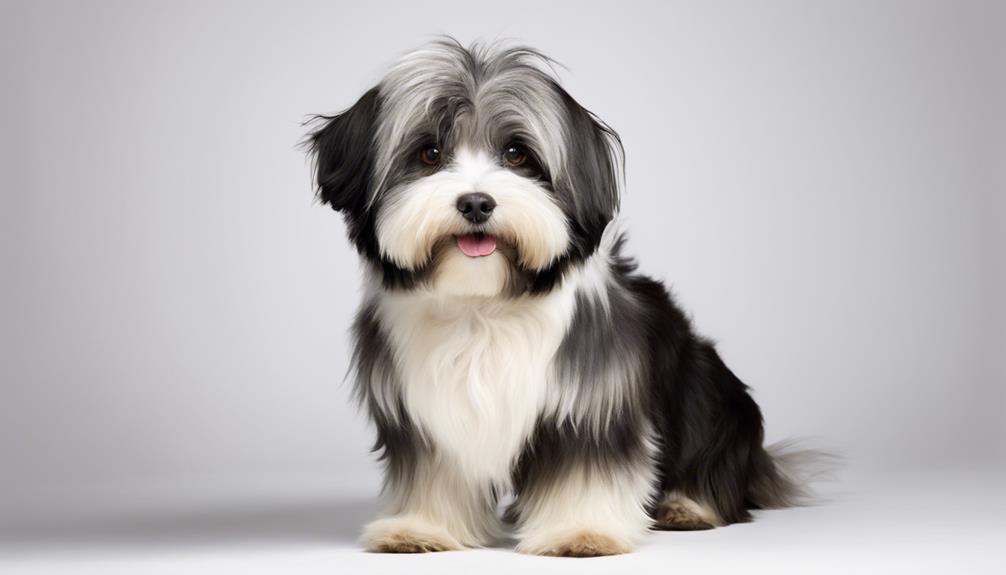
Shedding characteristics vary among dog breeds, with some categorized as non-shedding due to their coat structures. Havanese dogs fall into the category of low-shedding breeds because of their single coat structure. Unlike double-coated breeds, Havanese shed minimally since they lack an undercoat. This results in their shedding being more controlled and less noticeable compared to breeds with heavy shedding tendencies.
To manage Havanese shedding, regular grooming and maintenance are essential to prevent matting and keep their coat healthy. Additionally, individuals with allergies might find Havanese suitable companions due to their minimal shedding characteristics.
Impact of Shedding on Household Cleanliness

Regularly cleaning our homes is essential to manage the shedding of Havanese dogs. Vacuuming, sweeping, and dusting help control the fur around our living spaces.
Using washable pet bedding and covers can also assist in containing shedding, ensuring a tidy household.
Shedding Frequency
Managing the shedding frequency of Havanese dogs is essential for maintaining a clean household environment. When it comes to shedding in Havanese, understanding how often it occurs can help you stay ahead in managing pet hair. Here are some key points to take into account:
- Havanese dogs have minimal shedding due to their single coat structure, making them a great choice for those with allergies.
- Shedding in Havanese is moderate and less frequent compared to breeds with double coats.
- Regular grooming practices such as brushing and bathing play an important role in managing loose hair and keeping the coat in good condition.
- Shedding frequency can vary based on factors like seasons, temperature changes, and hormonal fluctuations in Havanese dogs.
Cleaning Strategies
To maintain a tidy household environment amidst Havanese shedding, incorporating effective cleaning strategies is essential. Regular cleaning, such as vacuuming, sweeping, and dusting, plays a vital role in managing pet shedding around the home.
Using washable pet bedding and covers can help contain the shedding, ensuring a tidy living environment for both you and your furry friend. Additionally, employing tools like lint rollers and washing pet bedding regularly can aid in maintaining a hygienic home environment amidst pet shedding.
Shedding and Havanese Temperament
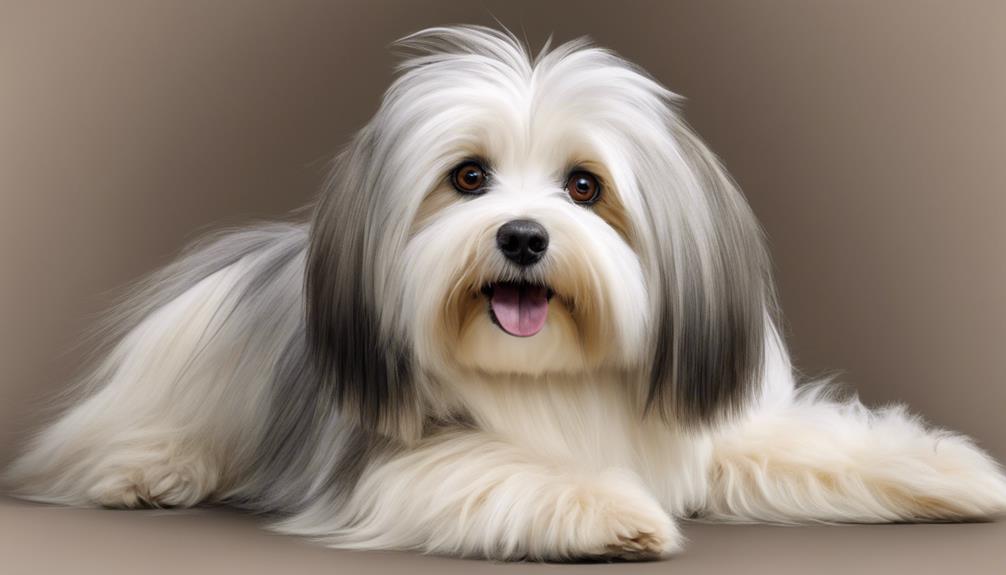
Shedding plays a significant role in understanding the temperament of Havanese dogs. Havanese are known for their minimal shedding, thanks to their single coat structure. Here are four key points to take into account:
- Grooming: Regular grooming is essential to manage loose hair in Havanese dogs with moderate shedding. This process helps maintain their coat and keeps shedding under control.
- Seasonal Variations: Shedding patterns in Havanese can vary depending on the seasons, temperature, and hormonal changes. Understanding these fluctuations can help predict shedding levels.
- Genetic Influence: Factors like diet, health, and genetics can influence the shedding patterns of Havanese dogs. By knowing these influences, owners can better care for their pets.
- Hair Growth Cycle: The longer hair growth cycle of Havanese leads to less frequent shedding compared to other breeds. This characteristic impacts their grooming needs and shedding frequency throughout the year.
Shedding and Havanese Health
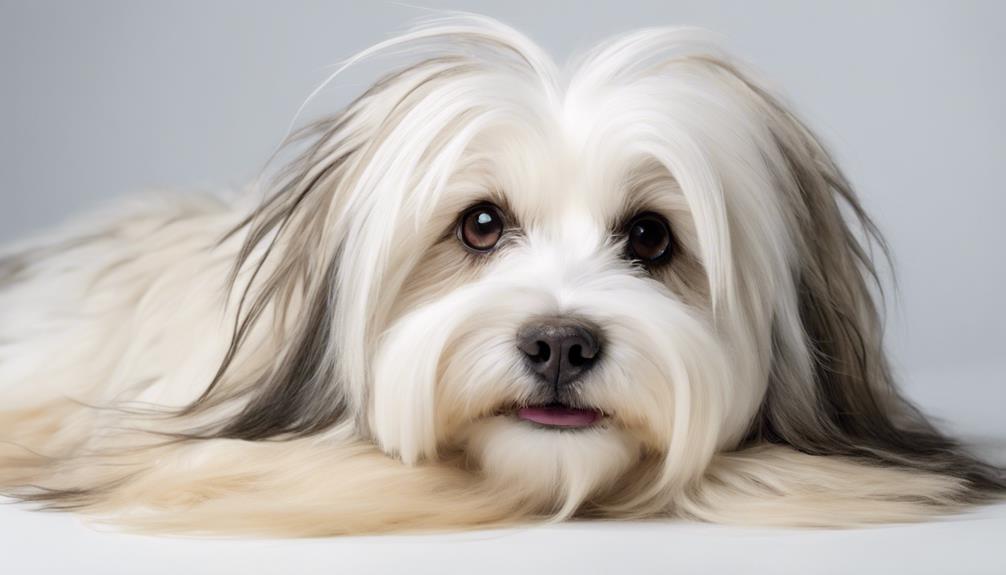
Factors such as diet, health, and genetics play a significant role in influencing the shedding patterns of Havanese dogs, impacting their overall health and well-being. Genetic factors determine the type of coat a Havanese will have, affecting shedding frequency.
Hormonal changes, seasonal variations, temperature fluctuations, and the overall health of the dog can also influence shedding patterns. Maintaining good health through proper diet and regular veterinary check-ups can help reduce the risk of health problems that may lead to excessive shedding.
Grooming needs are essential in managing shedding in Havanese dogs. Regular brushing helps remove loose fur and prevents matting, keeping the coat healthy and reducing shedding around the house.
Frequently Asked Questions
Does Havanese Dogs Shed a Lot?
Rest assured! Havanese dogs don't shed a lot. Their minimal shedding is due to the single coat structure they have, which sets them apart from breeds with double coats.
Factors like diet, health, and genetics play a role in how much they shed. With regular grooming, their shedding is manageable.
Are Havanese Dogs High Maintenance?
High maintenance? Absolutely. Havanese dogs demand attention and care. From grooming their luscious coats to keeping them mentally stimulated, these pups require dedication. It's like maintaining a delicate garden; constant pruning and nurturing are key.
But the rewards of a well-kept Havanese are priceless. They bring joy and companionship, making the effort worthwhile.
What Are the Disadvantages of Havanese?
Disadvantages of owning a Havanese include potential health issues like patellar luxation and dental problems. Their affectionate nature may lead to separation anxiety and clinginess, requiring constant human companionship. Regular grooming to prevent matting is essential. Sensitivity to changes in routine or environment can impact their behavior.
Despite these challenges, the joy and love they bring make them a rewarding pet for those willing to put in the effort.
Are Havanese Dogs Hypoallergenic?
Yes, Havanese dogs aren't hypoallergenic, but they typically cause fewer allergic reactions due to their minimal shedding. Their single coat results in less dander and hair being released, making them a better choice for allergy sufferers compared to heavy shedders.
Regular grooming can further reduce allergens. With proper care, their shedding patterns are manageable, making them popular for those with sensitivities to pet dander.
Can Havanese Dogs Shed Excess Energy Through Barking?
Yes, Havanese dogs can shed excess energy through barking. Regular exercise and mental stimulation can help dogs avoid barking fatigue. It’s important to provide plenty of opportunities for physical activity and play to keep them happy and healthy.
Do Havanese dogs have a specific type of shedding?
Yes, Havanese dogs are known for their minimal shedding, making them a great choice for those with allergies. With their beautiful and long coats, they are not only hypoallergenic but also very popular as pets. Some popular German dog names for Havanese include Fritz, Heidi, and Hans.
Conclusion
To sum up, Havanese dogs shed minimally due to their hypoallergenic coat. Regular grooming practices, such as brushing and bathing, can help reduce shedding even further.
For example, Sarah brushes her Havanese, Coco, twice a week to keep her coat healthy and shiny, and to minimize shedding around the house.
By understanding shedding patterns, implementing proper grooming techniques, and managing allergies, Havanese owners can maintain a clean and comfortable home environment.










